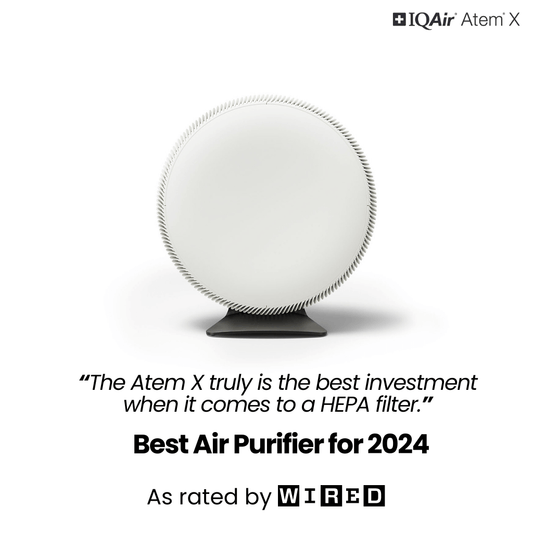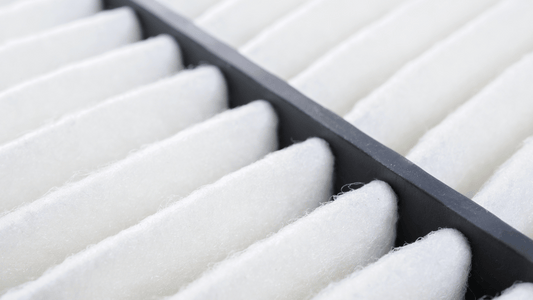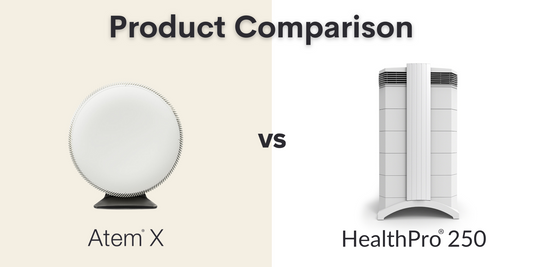HEPA Filtration for radioactive dust
High-Efficiency Particulate Air (HEPA) filters can reduce the risk of exposure to radioactive dust in indoor environments. Radioactive dust can be a concern for public health and safety, as exposure to radiation through inhalation can cause short term and long term health problems. Several factors must come together to effectively protect an individual in an indoor environment from the exposure to airborne radioactive dust. Most of these factors will not be discussed in this post. We will, however, discuss how a reliable filtration system such as a HEPA filter can play an essential part to filter radioactive dust out of the air.
HEPA filters are designed to trap the broadest range of particle contamination from the air, and have a minimum efficiency of 99.95% in removing airborne contaminants at 0.3 microns. This makes HEPA filters suitable for removing radioactive particles from the air, as they are able to capture even the smallest particles - including radioactive dust. The high level of filtration efficiency of a professional HEPA filter can ensure that the filtered air that is released from the HEPA air purifier is virtually free from any particulate contamination.
Reducing the risk of indoor exposure to radioactive dust can be aided by cleaning contaminated outside air before it enters the indoor environment. Creating such a 'positive pressure environment' is a priority, as it supports the directional airflow from indoor to outdoor environment. This reduces the risk of natural ventilation (i.e. contaminated outdoor air leaking into the indoor environment). If needed the indoor air can then additionally be cleaned through recirculation of a HEPA air purifier.
The European HEPA-filter test norm EN1822 verifies that a given filter media has been classified to capture even the smallest airborne contaminants at a minimum efficiency of 99.5%. This norm applies only to the filter media and is not representative of an air purifier as a whole. Furthermore, not all HEPA filters are suitable for removing radioactive dust, as the term 'HEPA' is not regulated in the UK. Unsuitable air purifiers might be advertised as 'HEPA air purifiers', even though their whole system filtration efficiency is well below the HEPA filtration efficiency. Some HEPA filters may also not have the necessary durability to withstand the effects of elevated levels of radiation. The filter material can break down when exposed to radiation, which would compromise the air purifier’s ability in filtering out radioactive particles.
To ensure that the HEPA filter is capable of removing radioactive dust, it's important to select a filter that is specifically rated for the specific radioactive isotopes present. This will ensure that the filter is made from materials that are durable enough to withstand exposure to the radioactive particles, and that it will continue to provide effective filtration over time. Furthermore, the filtration efficiency of the air purifier should to be individually tested, certified and guaranteed to meet the HEPA filtration efficiency for the whole air purifier as such, not just for the filter in it- i.e. the system should to be certified leakage-free.
Was the HEPA filter developed to remove radioactive dust?
HEPA (High-Efficiency Particulate Air) filters were developed in the 1940s. The exact date of development is not clear, but it is known that HEPA filters were developed as part of the Manhattan Project in Los Alamos during World War II.
The US government was searching for a way to filter radioactive particles from the air in the production of atomic bombs, leading to the development of HEPA filters. The technology was later adapted for use in air purification systems for medical and manufacturing environments, general buildings, and domestic homes. Today, the term ‘HEPA’ refers to not only the filtration technology but also an efficiency standard. As briefly touched upon above, HEPA filters are capable of removing particles at 0.3 microns at a minimum efficiency of 99.97%; and it is this standard, as stated by the U.S. government, that a filter must meet in order for it to be a true HEPA filter. Particles that are smaller or larger than 0.3 micron will be filtered with a greater filtration efficiency than 99.97%.
As such, the high efficiency and reliability of a HEPA filter means they are particularly ideal for high quality air purifiers to remove a variety of airborne contaminants, such as traffic soot, viruses and bacteria, pollen, mould spores, pet dander, as well as dust.
What was the Manhattan Project?
The Manhattan Project was a top-secret US government research program during World War II with the goal of developing the world's first atomic bomb. It was named after the Manhattan Engineer District of the US Army Corps of Engineers, which managed the program. The project brought together leading scientists, engineers, and military personnel from the US, UK, and Canada to work on developing the bomb. The project was primarily focused on two sites, one in Los Alamos, New Mexico, and another in Oak Ridge, Tennessee.
The project was successful in producing the first atomic bomb, which was tested on July 16, 1945 in Alamogordo, New Mexico. The use of atomic bombs marked a turning point in modern warfare and played a significant role in the ending of World War II.
How has HEPA Filtration developed?
HEPA (High-Efficiency Particulate Air) filtration technology has evolved significantly since its development in the 1940s. Some of the key developments in HEPA filtration include:
Improved materials: HEPA filters were initially made from simple fiberglass or paper, but further advancement in the materials used have led to the development of more durable and efficient filters, that are more resistant to clogging and thus provide longer filter life.
Polypropylene and electrospun materials have been used in the attempt to make HEPA air purifiers. These materials are easier to handle and are thus cheaper. However, polypropylene filters lack the structural integrity that a modern fibreglass filter can provide, and thus suffers comparatively from premature loading. Electrically charged filters are also not suited for sensitive environments, and would not be recommended to filter radioactive dust, as their filtration efficiency decreases very quickly as the charge in the filter dissipates.
The size of HEPA filters has also increased over time, allowing for more efficient air flow and higher filtration capacity. This has enabled the development of air purifiers and that can effectively remove more contaminants from the air at a much faster rate and in larger environments.
Integration with other technologies: HEPA filters are now often integrated with other technologies, such as activated carbon to enhance their performance and provide additional benefits. For example, HEPA filters combined with activated carbon can effectively remove both particulate and gaseous or odours contaminants from the air.
The addition of UVC light to a proper HEPA air purifier, however, doesn’t seem to provide any additional benefits. The exposure time with which contamination such as viruses travels through an air purifier is too short for a UVC light to destroy the contaminant. Furthermore, a professional and leakage free HEPA air purifier will singlehandedly capture all viruses, so that UVC only adds additional cost and possible risks. To find out more visit our UVC Air Purifier article.
Cost-effectiveness: The cost of HEPA filters has decreased over time, making them more affordable and accessible to a wider range of consumers. This has led to increased use of HEPA filters in general medical environments, manufacturing, domestic homes, and other applications, helping to improve air quality and protect public health.
Over the last 60 years, HEPA filtration technology has undergone significant development since its inception, resulting in improved efficiency, larger filter sizes, enhanced performance, integration with other technologies, and cost-effectiveness. These advancements have made HEPA filters a powerful tool in the removal of airborne contaminants and the protection of public health.
How to protect yourself from radioactive dust
To protect yourself from radioactive dust, it is recommended to follow these guidelines:
Avoid contaminated areas: If you know or suspect an area is contaminated with radioactive dust, it's best to avoid it altogether.
Wear protective clothing: If you must enter a contaminated area, wear protective clothing, such as a coverall, gloves, and a mask to protect your skin and respiratory system.
Wash your skin and clothing: Upon leaving a contaminated area, wash your skin and clothing thoroughly to remove any radioactive dust that may have accumulated.
Use air filtration: If you are concerned about radioactive dust in your home or workplace, a professional air purifier, equipped with a HEPA (High-Efficiency Particulate Air) filter, and used in the appropriate way, can help to reduce the exposure to radioactive dust from in an indoor environment.
Stay informed: Keep up-to-date with the latest information and guidelines from local health authorities and government agencies to ensure you are taking the appropriate precautions.
Seek medical attention if necessary: If you suspect you have been exposed to a significant amount of radioactive dust, seek medical attention immediately, as exposure to high levels of radiation can have significant health consequences, including radiation sickness, cancer, and other long-term health effects. Your doctor can determine the appropriate course of action based on the type and amount of radioactive material you were exposed to.




